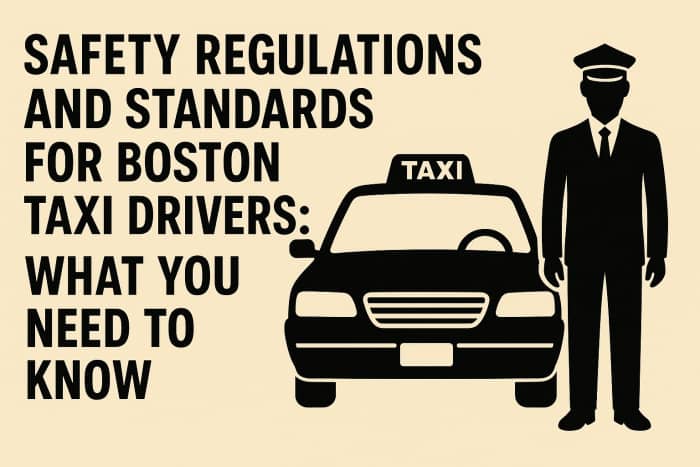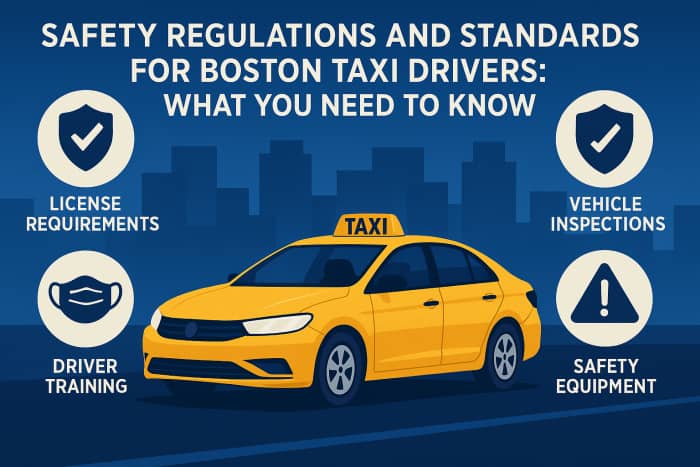Category : General Topics

Taxis are a vital part of Boston's transportation network, offering a convenient and reliable option for residents and tourists alike. To ensure the safety of both drivers and passengers, the city enforces a robust set of regulations and standards. Overseen by the Hackney Carriage Unit of the Boston Police Department, these rules cover driver licensing, vehicle maintenance, passenger safety, and operational procedures. This article explores the key elements of these regulations and what they mean for Boston’s taxi industry.
The Hackney Carriage Unit, established in 1854, is the oldest specialized unit within the Boston Police Department. It oversees all Boston taxi services, sightseeing vehicles, horse-drawn carriages, and pedi-cabs in the city, operating under Chapter 392 of the Acts of 1930. Led by a Boston Police Superior Officer known as the Inspector of Carriages, the unit ensures safety, professionalism, and compliance across the industry. In a significant update, the department recently revised the rules governing Hackney Carriages—the first comprehensive overhaul since 1950—demonstrating its dedication to addressing modern safety needs.
Becoming a Boston taxi driver requires meeting strict criteria. Drivers must obtain a hackney license, which involves a detailed background check and a review of their driving history. This license must be visibly displayed while they operate their vehicle. Additionally, drivers working at Logan Airport must comply with rules set by both the Boston Police Department and the Massachusetts Port Authority (Massport). These requirements ensure that only qualified, trustworthy individuals drive taxis, safeguarding passengers and maintaining public confidence.
Explore More- Boston to Amesbury MA: Everything You Need to Know Before You Go
Boston’s taxis, officially termed Hackney Carriages, must adhere to high safety and operational standards. Every taxi is equipped with a sealed Taximeter, which must be functional, visible to passengers, and illuminated at all times to guarantee fair pricing. The Hackney Carriage Unit conducts regular inspections to confirm that vehicles are safe, clean, and properly equipped. These checks assess registration, equipment like GPS and partitions, and overall condition. Taxi companies also enforce their own maintenance schedules—such as oil changes and tire rotations—to keep fleets in top shape, further enhancing safety and reliability.

Protecting passengers is a cornerstone of Boston’s taxi regulations. Taxis must accept Taxi Discount Coupons, available at locations like Boston City Hall, making transportation more accessible. Child safety is another priority: per Boston Police and Road Transport laws, taxis must provide appropriate child seats upon request, with penalties possible for non-compliance. Passengers can enhance their own safety by checking the driver’s ID and license before entering and opting for reputable services. These measures collectively create a secure riding experience.
Explore More- Top Attractions and Places to Visit in Maynard, MA
Specific rules govern how taxis operate, especially at busy locations like Logan Airport. Drivers must follow instructions from Ground Transportation Agents and pass through designated Taxicab Pool Areas before picking up passengers. While waiting at Commercial Vehicle Stands, they must stay in their vehicles and are barred from allowing non-passengers inside. These protocols ensure orderly operations, reduce congestion, and prevent unauthorized pickups, contributing to a safer and more efficient system.
The rise of ride-sharing services like Uber and Lyft has posed challenges for Boston’s taxi industry, including traditional Boston town car services, impacting drivers’ livelihoods and the value of taxi medallions. In response, the city has been adapting its regulations. Recent proposals from city councilors aim to ease regulatory burdens on taxis, helping them compete with transportation networking companies (TNCs). Efforts also include addressing enforcement gaps and medallion costs. Despite these hurdles, Boston remains focused on preserving a safe, viable taxi sector through thoughtful regulatory adjustments.
Explore More- Why Amherst Car Services are the Smart Choice Over Rideshares
Boston’s safety regulations for taxi drivers are a comprehensive framework designed to protect everyone involved. From rigorous licensing and vehicle standards to passenger protections and operational guidelines, these rules reflect the city’s commitment to a dependable transportation system. As the industry navigates challenges like competition from ride-sharing platforms, ongoing updates to these regulations will be crucial. By upholding high safety standards, Boston ensures that taxis remain a trusted option for getting around the city.
The Hackney Carriage Unit, established in 1854, is the oldest specialized unit within the Boston Police Department. It oversees all Boston taxi services, sightseeing vehicles, horse-drawn carriages, and pedi-cabs in the city, operating under Chapter 392 of the Acts of 1930. Led by a Boston Police Superior Officer known as the Inspector of Carriages, the unit ensures safety, professionalism, and compliance across the industry. In a significant update, the department recently revised the rules governing Hackney Carriages—the first comprehensive overhaul since 1950—demonstrating its dedication to addressing modern safety needs.
© Copyright Boston Airport Express Inc. 2025Powered By Nth Dimension